143
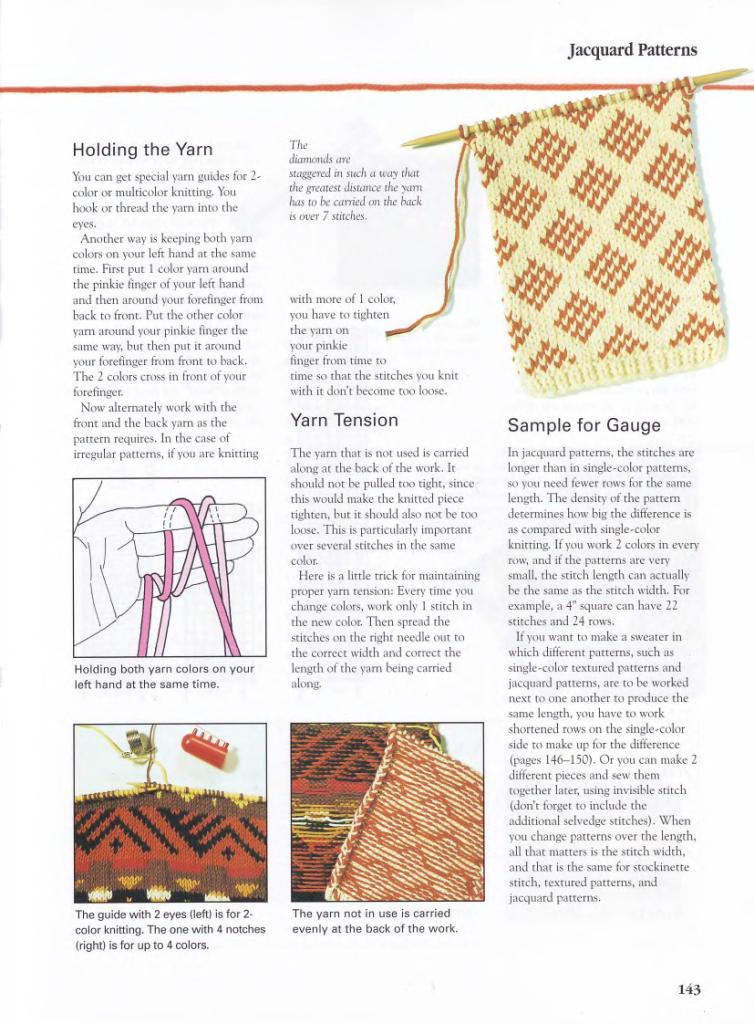
Jacąuard Patterns
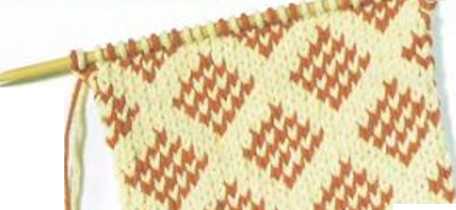
Holding the Yarn
You can gct spccial yam gutde.s for 2-color or multicolor knitting. You hook or rhread thc yam into the eycs.
Anothcr way is kcepmg both yam colon on your lefr hand at thc same urno. First put 1 color yam aiound thc pinkie finger ot your leff hand and then around your forefinger from hack ro fnmt. Put thc orher color yam around your pinkie finger the same way, hut then put it around your forefinger from front to hack. The 2 colors emss in front ofyour forefinger.
Nmv altematcly work with thc front and the hack yarn as thc paltem rcqutres. In the case ot ir rogu lar patterns. if you aro knitting
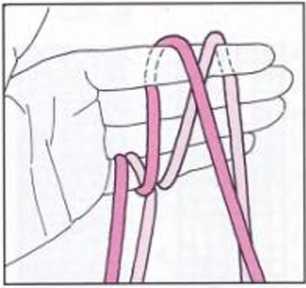
Holding both yarn colors on your loft hand at the same time.
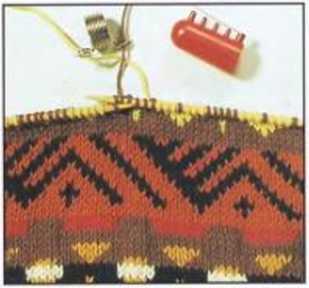
The guide with 2 eyes (leftl is for 2-color knitting. The one with 4 notches (right) is for up to 4 colors.
The dumunub are
*(4ggm*J ni łiic/i u um tiut the greatest distance the yam hus to be otmed on the hack u (fver 7 uitches.
with moro of 1 color, you have to tighten thc yarn on your pinkie finger Irian timc to time so that the stitches you knit with it don't hccomc too łoosc.
Yarn Tension
The yarn that i> not uscd is cnrricd along at the hack of thc work. It should not be pulled tix> tight. sińce this would make the knitted piece righten, hut ir should also noc be too loose. Tlus is particularly imporrant ovcr scvcral stitches in thc same color.
Herc is a linie rrick for maintnining proper yam tension: Every timc you change colors, work only 1 sritch in thc new color. Then sprc.id the stitches on the riglu needle out to thc correct widtlt and correct thc length of the yam hemg carned along.
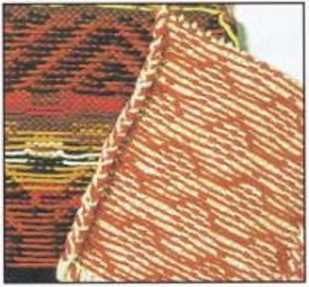
The yam not in use is carried evenly at the back of the work.
/a-
Sample for Gauge
In |acquard patterns, rhc stitches are longer than in single-color patterns, so you need fewer rows for rhe same length. The density of the patiem derermtnes how big the diiterence is as cotnpared with single-color knitting. If you work 2 colon* in evcry rnw, and if the patterns are verv smali, thc ‘titch length can actually he the same as the stitch width. For example. a 4" squnre can havc 22 stitches and 24 rows.
It you want to make a sweater in which different patterns, such as single-color textured patterns and jacquard patterns. arc to hc worked next to one another to produce the same length. you havc to work shortened rows on the single-color side ro make up tor thc diftcrcncc (pages 146-150). Or you can make 2 Jifferent pieces and sew them together latcr, using invbible stitch (dont torget to includc the additional sch edgc stitches). Whcn you change patterns over rhe length. all that matters i- the stitch width. and that is rhe same for stocldnetre stitch, texturcd patterns. and iacquard patterns.
143
Wyszukiwarka
Podobne podstrony:
Jacquard PatternsWeaving In Yarn Carried Across the Back of the Work If you are working large j
essent?rving?30 E S S E N T l A L W O O I) C A R V I N G T E C H X I Q U E S Fig 12.6 The małe skele
smpb 16 Disease is Evil urge you to eonie to me FIRST, with the assuranec that I can help you—not th
28fig06 OLE Container Control Example File Object Window (5
scheme Flyback Driver 47 - 200 pH 10A If you don’t have the irfp250’s you can use a couple of semico
screenshot 4 John Smith This is a description for the user. You can be bold and oblique but it
Are you ready to TAKfc CHARGt OF rOUR LII CREATE THE LIFE YOU Dy Jś BE AU ł HAT YOU CAN f Jf
013 7 Jet Connect the dots from A to Z. Color. Way up high, up in the sky, you can see a jet fly by.
Creating an Option File lf you need to specify startup options when you run the server, you can indi
BS page01 Must-have designs for every week of the year! you can make!Beacf^ SPECIA
Knit-in Facings and vests, the front facings can l>e knit as you are working the piece
Openwork Patterns Left double decrease wrth 2 yam overs: Put the yarn over the needle, then sli
Shortened Rows for Slantcd PatternsShortened Rows on the Right Side ITurn the work at the desired po
Entrelac Patterns This child s sweater can be worked in any size. The diagram shows the differe
Internet access Wifi network is available for participants during the conference. You can log into t
calibre cover Finding the perfect roommate can be a real challenge, but when you already share your
więcej podobnych podstron